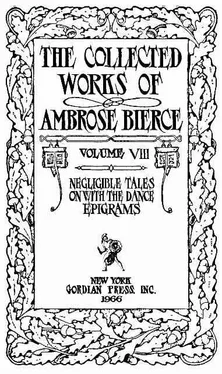Ambrose Bierce - The Collected Works of Ambrose Bierce, Volume 8 / Epigrams, On With the Dance, Negligible Tales
Здесь есть возможность читать онлайн «Ambrose Bierce - The Collected Works of Ambrose Bierce, Volume 8 / Epigrams, On With the Dance, Negligible Tales» весь текст электронной книги совершенно бесплатно (целиком полную версию без сокращений). В некоторых случаях можно слушать аудио, скачать через торрент в формате fb2 и присутствует краткое содержание. Жанр: Классическая проза, на английском языке. Описание произведения, (предисловие) а так же отзывы посетителей доступны на портале библиотеки ЛибКат.
- Название:The Collected Works of Ambrose Bierce, Volume 8 / Epigrams, On With the Dance, Negligible Tales
- Автор:
- Жанр:
- Год:неизвестен
- ISBN:нет данных
- Рейтинг книги:4 / 5. Голосов: 1
-
Избранное:Добавить в избранное
- Отзывы:
-
Ваша оценка:
- 80
- 1
- 2
- 3
- 4
- 5
The Collected Works of Ambrose Bierce, Volume 8 / Epigrams, On With the Dance, Negligible Tales: краткое содержание, описание и аннотация
Предлагаем к чтению аннотацию, описание, краткое содержание или предисловие (зависит от того, что написал сам автор книги «The Collected Works of Ambrose Bierce, Volume 8 / Epigrams, On With the Dance, Negligible Tales»). Если вы не нашли необходимую информацию о книге — напишите в комментариях, мы постараемся отыскать её.
The Collected Works of Ambrose Bierce, Volume 8 / Epigrams, On With the Dance, Negligible Tales — читать онлайн бесплатно полную книгу (весь текст) целиком
Ниже представлен текст книги, разбитый по страницам. Система сохранения места последней прочитанной страницы, позволяет с удобством читать онлайн бесплатно книгу «The Collected Works of Ambrose Bierce, Volume 8 / Epigrams, On With the Dance, Negligible Tales», без необходимости каждый раз заново искать на чём Вы остановились. Поставьте закладку, и сможете в любой момент перейти на страницу, на которой закончили чтение.
Интервал:
Закладка:
VI
CAIRO REVISITED
Having glanced, briefly, and as through a glass darkly, at the dance as it existed in the earliest times of which we have knowledge in the country whence, through devious and partly obliterated channels, we derived much of our civilization, let us hastily survey some of its modern methods in the same region—supplying thereby some small means of comparison to the reader who may care to note the changes undergone and the features preserved.
We find the most notable, if not the only, purely Egyptian dancer of our time in the Alme or Ghowazee . The former name is derived from the original calling of this class—that of reciting poetry to the inmates of the harem, the latter they acquired by dancing at the festivals of the Ghors, or Memlooks. Reasonably modest at first, the dancing of the Alme became, in the course of time, so conspicuously indelicate that great numbers of the softer sex persuaded themselves to its acquirement and practice, and a certain viceregal Prude once contracted the powers of the whole Cairo contingent of Awalim into the pent up Utica of the town of Esuch, some five hundred miles removed from the viceregal dissenting eye. For a brief season the order was enforced, then the sprightly sinners danced out of bounds, and their successors can now be found by the foreign student of Egyptian morals without the fatigue and expense of a long journey up the Nile.
The professional dress of the Alme consists of a short embroidered jacket, fitting closely to the arms and back, but frankly unreserved in front, long loose trousers of silk sufficiently opaque somewhat to soften the severity of the lower limbs, a Cashmere shawl bound about the waist and a light turban of muslin embroidered with gold. The long black hair, starred with small coins, falls abundantly over the shoulders. The eyelids are sabled with kohl, and such other paints, oils, varnishes and dyestuffs are used as the fair one—who is a trifle dark, by the way—may have proved for herself, or accepted on the superior judgment of her European sisters. Altogether, the girl's outer and visible aspect is not unattractive to the eye of the traveler, however faulty to the eye of the traveler's wife. When about to dance, the Alme puts on a lighter and more diaphanous dress, eschews her slippers, and with a slow and measured step advances to the centre of the room—her lithe figure undulating with a grace peculiarly serpentile. The music is that of a reed pipe or a tambourine—a number of attendants assisting with castanets. Perhaps the "argument" of her dance will be a love-passage with an imaginary young Arab. The coyness of a first meeting by chance her gradual warming into passion their separation, followed by her tears and dejection the hope of meeting soon again and, finally, the intoxication of being held once more in his arms—all are delineated with a fidelity and detail surprising to whatever of judgment the masculine spectator may have the good fortune to retain.
One of the prime favorites is the "wasp dance," allied to the Tarantella. Although less pleasing in motive than that described, the wasp dance gives opportunity for movements of even superior significance—or, as one may say, suggestures. The girl stands in a pensive posture, her hands demurely clasped in front, her head poised a little on one side. Suddenly a wasp is heard to approach, and by her gestures is seen to have stung her on the breast. She then darts hither and thither in pursuit of that audacious insect, assuming all manner of provoking attitudes, until, finally, the wasp having been caught and miserably exterminated, the girl resumes her innocent smile and modest pose.
VII
JAPAN WEAR AND BOMBAY DUCKS
Throughout Asia, dancing is marked by certain characteristics which do not greatly differ, save in degree, among the various peoples who practice it. With few exceptions, it is confined to the superior sex, and these ladies, I am sorry to confess, have not derived as great moral advantage from the monopoly as an advocate of dancing would prefer to record.
Dancing—the rhythmical movement of the limbs and body to music—is, as I have endeavored to point out, instinctive, hardly a people, savage or refined, but has certain forms of it. When, from any cause, the men abstain from its execution it has commonly not the character of grace and agility as its dominant feature, but is distinguished by soft, voluptuous movements, suggestive posturing, and all the wiles by which the performer knows she can best please the other sex, the most forthright and effective means to that commendable end being evocation of man's baser nature. The Japanese men are anti-dancers from necessity of costume, if nothing else, and the effect is much the same as elsewhere under the same conditions the women dance, the men gloat and the gods grieve.
There are two kinds of dances in Japan, the one not only lewd, but—to speak with accurate adjustment of word to fact—beastly, in the other grace is the dominating element, and decency as cold as a snow storm. Of the former class, the "Chon Nookee" is the most popular. It is, however, less a dance than an exhibition, and its patrons are the wicked, the dissolute and the European. It is commonly given at some entertainment to which respectable women have not the condescension to be invited—such as a dinner party of some wealthy gentleman's gentlemen friends. The dinner-served on the floor—having been impatiently tucked away, and the candies, cakes, hot saki and other necessary addenda of a Japanese dinner brought in, the "Chon Nookee" is demanded, and with a modest demeanor, worn as becomingly as if it were their every day habit, the performers glide in, seating themselves coyly on the floor, in two rows. Each dancing girl is appareled in such captivating bravery as her purse can buy or her charms exact. The folds of her varicolored gowns crossing her bosom makes combinations of rich, warm hues, which it were folly not to admire and peril to admire too much. The faces of these girls are in many instances exceedingly pretty, but with that natural—and, be it humbly submitted, not very creditable—tendency of the sex to revision and correction of nature's handiwork, they plaster them with pigments dear to the sign painter and temper the red glory of their lips with a bronze preparation which the flattered brass founder would no doubt deem kissable utterly. The music is made by beating a drum and twanging a kind of guitar, the musician chanting the while to an exceedingly simple air words which, in deference to the possible prejudices of those readers who may be on terms of familarity with the Japanese language, I have deemed it proper to omit—with an apology to the Prudes for the absence of an appendix in which they might be given without offense. (I had it in mind to insert the music here, but am told by credible authority that in Japan music is moral or immoral without reference to the words that may be sung with it. So I omit—with reluctance—the score, as well as the words.)
The chanting having proceeded for a few minutes the girls take up the song and enter spiritedly into the dance. One challenges another and at a certain stage of the lively song with the sharp cry "Hoi!" makes a motion with her hand. Failure on the part of the other instantaneously and exactly to copy this gesture entails the forfeiture of a garment, which is at once frankly removed. Cold and mechanical at the outset, the music grows spirited as the girls grow nude, and the dancers themselves become strangely excited as they warm to the work, taking, the while, generous potations of saki to assist their enthusiasm.
Let it not be supposed that in all this there is anything of passion, it is with these women nothing more that the mere mental exaltation produced by music, exercise and drink. With the spectators (I have heard) it fares somewhat otherwise.
Читать дальшеИнтервал:
Закладка:
Похожие книги на «The Collected Works of Ambrose Bierce, Volume 8 / Epigrams, On With the Dance, Negligible Tales»
Представляем Вашему вниманию похожие книги на «The Collected Works of Ambrose Bierce, Volume 8 / Epigrams, On With the Dance, Negligible Tales» списком для выбора. Мы отобрали схожую по названию и смыслу литературу в надежде предоставить читателям больше вариантов отыскать новые, интересные, ещё непрочитанные произведения.
Обсуждение, отзывы о книге «The Collected Works of Ambrose Bierce, Volume 8 / Epigrams, On With the Dance, Negligible Tales» и просто собственные мнения читателей. Оставьте ваши комментарии, напишите, что Вы думаете о произведении, его смысле или главных героях. Укажите что конкретно понравилось, а что нет, и почему Вы так считаете.




